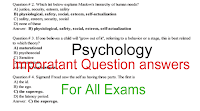Question # 1. Children learn through modeling or imitation. Such a suggestion would be best associated with
A) Skinner
B) Pavlov
C) Bandura
D) Erikson
Answer: C) Bandura
Question # 2. Which list below explains Maslow's hierarchy of human needs?
A) justice, security, esteem, safety
B) physiological, safety, social, esteem, self-actualization
C) safety, esteem, security, social
D) none of these
Answer: B) physiological, safety, social, esteem, self-actualization
Question # 3. If one believes a child will "grow out of it", referring to a behavior or a stage, this is best related to which theory?
A) maturational
B) psychosocial
C) Sensitive
D) constructivist
Answer: A) maturational
Question # 4. Sigmund Freud saw the self as having three parts. The first is
A) the id.
B) the ego.
C) the superego.
D) the latency period.
Answer: C) the superego.
Question # 5. Gender differences are influenced by
A) culture.
B) environment.
C) nature and nurture.
D) all of these
Question # 6. Maturational theory suggests
A) children are influenced greatly by their environment.
B) children grow and change based upon their own genetic makeup.
C) children are born as blank slates.
D) all of these
Answer: B) children grow and change based upon their own genetic makeup.
Question # 7. Sigmund Freud is known for
A) stages of cognitive development.
B) the theory of psychosexual development.
C) studying the behavior of monkeys.
D) none of these
Answer: B) the theory of psychosexual development.
Question # 8. Piaget's three mechanisms for learning include
A) homologous, hierarchical, decalage.
B) adaptation, assimilation, and accommodation.
C) sensorimotor, preoperational, and concrete operations.
D) reinforcers, stimulus, and response.
Answer: B) adaptation, assimilation, and accommodation.
Question # 9. Behavioral theorists include
A) Pavlov, Skinner, and Watson.
B) Piaget, Vygotsky, and Freud.
C) Bandura, Pavlov, and Piaget.
D) none of these
Answer: A) Pavlov, Skinner, and Watson.
Question # 10. Which of the following terms are related to Lev Vygotsky?
A) sensorimotor, preoperational, concrete, and formal operations
B) zone of proximal development
C) scaffolding
D) Both B and C
Answer: D) Both B and C
More Question answers will be published soon.
These questions Copied from www.questionpapersdownload.com visit www.questionpapersdownload.com for more questions
A) Skinner
B) Pavlov
C) Bandura
D) Erikson
Answer: C) Bandura
Question # 2. Which list below explains Maslow's hierarchy of human needs?
A) justice, security, esteem, safety
B) physiological, safety, social, esteem, self-actualization
C) safety, esteem, security, social
D) none of these
Answer: B) physiological, safety, social, esteem, self-actualization
Question # 3. If one believes a child will "grow out of it", referring to a behavior or a stage, this is best related to which theory?
A) maturational
B) psychosocial
C) Sensitive
D) constructivist
Answer: A) maturational
Question # 4. Sigmund Freud saw the self as having three parts. The first is
A) the id.
B) the ego.
C) the superego.
D) the latency period.
Answer: C) the superego.
A) culture.
B) environment.
C) nature and nurture.
D) all of these
Answer: D) all of these
A) children are influenced greatly by their environment.
B) children grow and change based upon their own genetic makeup.
C) children are born as blank slates.
D) all of these
Answer: B) children grow and change based upon their own genetic makeup.
Question # 7. Sigmund Freud is known for
A) stages of cognitive development.
B) the theory of psychosexual development.
C) studying the behavior of monkeys.
D) none of these
Answer: B) the theory of psychosexual development.
A) homologous, hierarchical, decalage.
B) adaptation, assimilation, and accommodation.
C) sensorimotor, preoperational, and concrete operations.
D) reinforcers, stimulus, and response.
Answer: B) adaptation, assimilation, and accommodation.
A) Pavlov, Skinner, and Watson.
B) Piaget, Vygotsky, and Freud.
C) Bandura, Pavlov, and Piaget.
D) none of these
Answer: A) Pavlov, Skinner, and Watson.
Question # 10. Which of the following terms are related to Lev Vygotsky?
A) sensorimotor, preoperational, concrete, and formal operations
B) zone of proximal development
C) scaffolding
D) Both B and C
Answer: D) Both B and C
More Question answers will be published soon.
These questions Copied from www.questionpapersdownload.com visit www.questionpapersdownload.com for more questions


